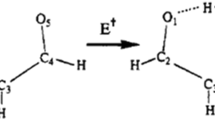Abstract
It has been shown earlier[1] that the relaxed force constants (RFCs) could be used as a measure of bond strength only when the bonds form a part of the complete valence internal coordinates (VIC) basis. However, if the bond is not a part of the complete VIC basis, its RFC is not necessarily a measure of bond strength. Sometimes, it is possible to have a complete VIC basis that does not contain the intramolecular hydrogen bond (IMHB) as part of the basis. This means the RFC of IMHB is not necessarily a measure of bond strength. However, we know that IMHB is a weak bond and hence its RFC has to be a measure of bond strength. We resolve this problem of IMHB not being part of the complete basis by postulating ‘equivalent’ basis sets where IMHB is part of the basis at least in one of the equivalent sets of VIC. As long as a given IMHB appears in one of the equivalent complete VIC basis sets, its RFC could be used as a measure of bond strength parameter.

The relaxed force constants (RFCs) could be used as a measure of bond strength when the bonds are part of the basis. We define more than one ‘equivalent’ complete VIC basis sets where the intramolecular hydrogen bond is part of atleast one of the basis sets.








Similar content being viewed by others
References
Majumder M and Manogaran S 2013 J. Chem. Sci. 125 9
Decius J C 1963 J. Chem. Phys. 38 241
Cyvin S J 1968 In Molecular Vibrations and Mean Square Amplitudes (Amsterdam: Elsevier)
Jones L H and Swanson B I 1976 Acc. Chem. Res. 9 128
Brandhorst K and Grunenberg J 2008 Chem. Soc. Rev. 37 1558 and references therein
Madhav M V and Manogaran S 2009 J. Chem. Phys. 131 174112
Jones L H 1970 Proc. Int. Conf. Coord. Chem. 13th [as given in Ref. 8]
Swanson B I 1976 J. Am. Chem. Soc. 98 3067
Baker J and Pulay P 2006 J. Am. Chem. Soc. 128 11324
Baker J 2006 J. Chem. Phys. 125 014103
Halgren T A 1990 J. Am. Chem. Soc. 112 4714
Pulay P, Fogarasi G, Pang F and Boggs J E 1979 J. Am. Chem. Soc. 101 2550
Tan B T, Demaison J and Rudolph H D 1979 J. Mol. Spectrosc. 76 104
Mallinson P D and Nemes L 1976 J. Mol. Spectrosc. 59 470
Hollenstein H and Gunthard Hs H 1980 J. Mol. Spectrosc. 84 457
Ozkabak A G and Goodman L 1987 J. Chem. Phys. 87 2564
Pulay P Fogarasi G and Boggs J E 1981 J. Chem. Phys. 74 3999
Torii H and Tasumi M 1995 J. Mol. Struct. 352/353 465
Gaussian 09, Revision D.01, Frisch M J, Trucks G W, Schlegel H B, Scuseria G E, Robb M A, Cheeseman J R, Scalmani G, Barone V, Mennucci B, Petersson G A, Nakatsuji H, Caricato M, X Li, Hratchian H P, Izmaylov A F, Bloino J, Zheng G, Sonnenberg J L, Hada M, Ehara M, Toyota K, Fukuda R, Hasegawa J, Ishida M, Nakajima T, Honda Y, Kitao O, Nakai H, Vreven T, Montgomery, Jr. J A, Peralta J E, Ogliaro F, Bearpark M, Heyd J J, Brothers E, Kudin K N, Staroverov V N, Kobayashi R, Normand J, Raghavachari K, Rendell A, Burant J C, Iyengar S S, Tomasi J, Cossi M, Rega N, Millam J M, Klene M, Knox J E, Cross J B, Bakken V, Adamo C, Jaramillo J, Gomperts R, Stratmann R E, Yazyev O, Austin A J, Cammi R, Pomelli C, Ochterski J W, Martin R L, Morokuma K, Zakrzewski V G, Voth G A, Salvador P, Dannenberg J J, Dapprich S, Daniels A D, Farkas Ö, Foresman J B, Ortiz J V, Cioslowski J and Fox D J, Gaussian, Inc. Wallingford CT, 2009
McIntosh D F and Peterson M R, 1989 Program UMAT, QCPE576, University of Indiana, Bloomington, IN47405
Fogarasi G and Pulay P 1985 In Vibrational Spectra and Structure J R Durig (Ed.) Vol. 14 (Amsterdam: Elsevier) p. 193
Yeh T S, Chang Y P and Su T M 1994 J. Phys. Chem. 98 8921
Cramer C J and Truhlar D G 1994 J. Am. Chem. Soc. 116 3892
Trindle C, Crum P and Douglass K 2003 J. Phys. Chem. 107A 6236
Chopra D, Guru Row T N, Arunan E and Klein R A 2010 J. Mol. Struct. 964 126
Petterson K A, Stein R S, Drake M D and Roberts J D 2005 Magn. Reson. Chem. 43 225
Acknowledgements
S.K.P. thanks the UGC, New Delhi, for a Research Fellowship and the authors thank Department of Science and Technology (DST), New Delhi, for supporting the Chemistry Department and IITK computational facilities.
Author information
Authors and Affiliations
Corresponding author
Additional information
Electronic supplementary material
Below is the link to the electronic supplementary material.
Rights and permissions
About this article
Cite this article
PANDEY, S.K., DAS, P., DAS, P.K. et al. Intramolecular hydrogen bond: Can it be part of the basis set of valence internal coordinates in normal mode analysis?. J Chem Sci 127, 1127–1134 (2015). https://doi.org/10.1007/s12039-015-0866-2
Received:
Revised:
Accepted:
Published:
Issue Date:
DOI: https://doi.org/10.1007/s12039-015-0866-2




